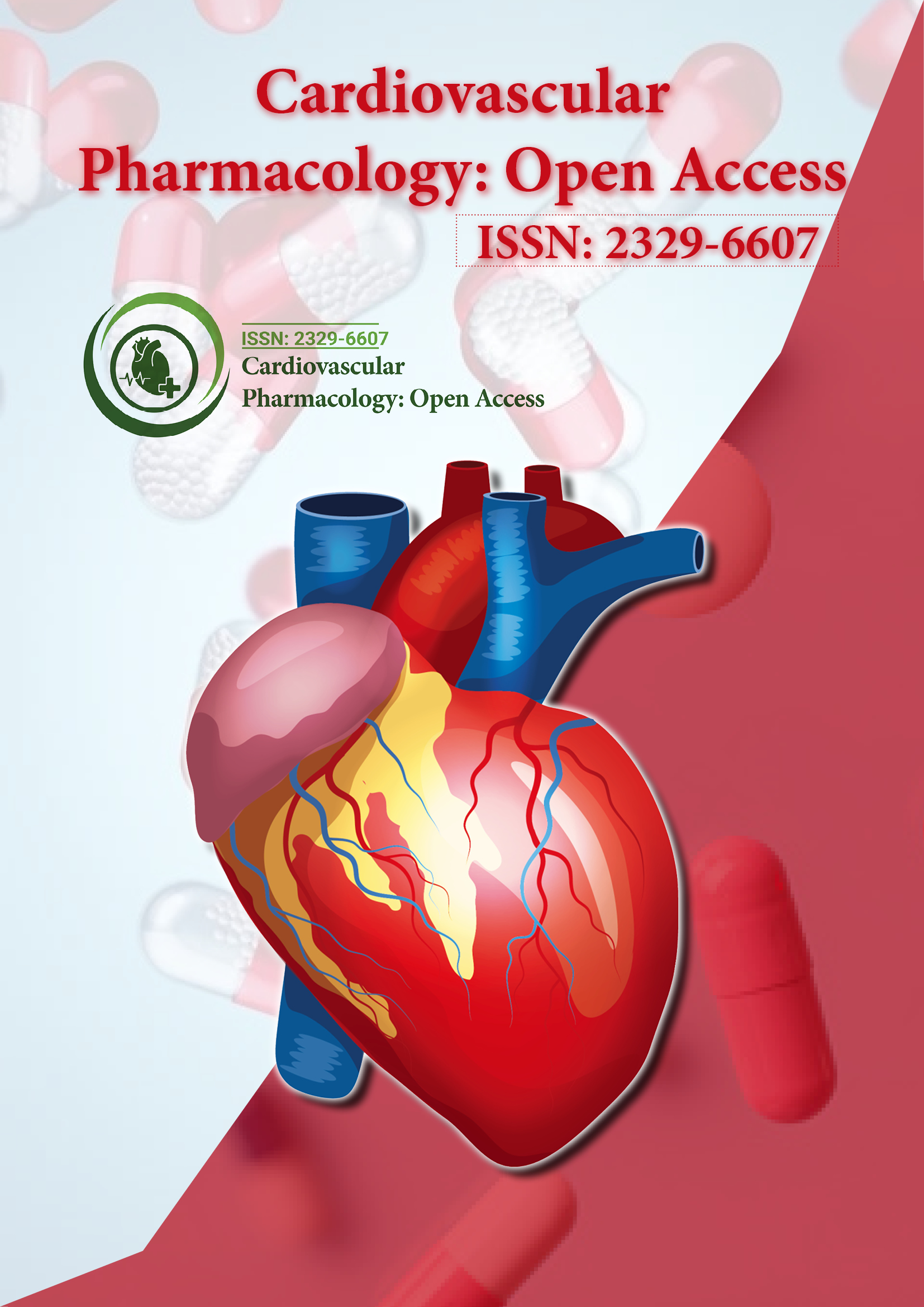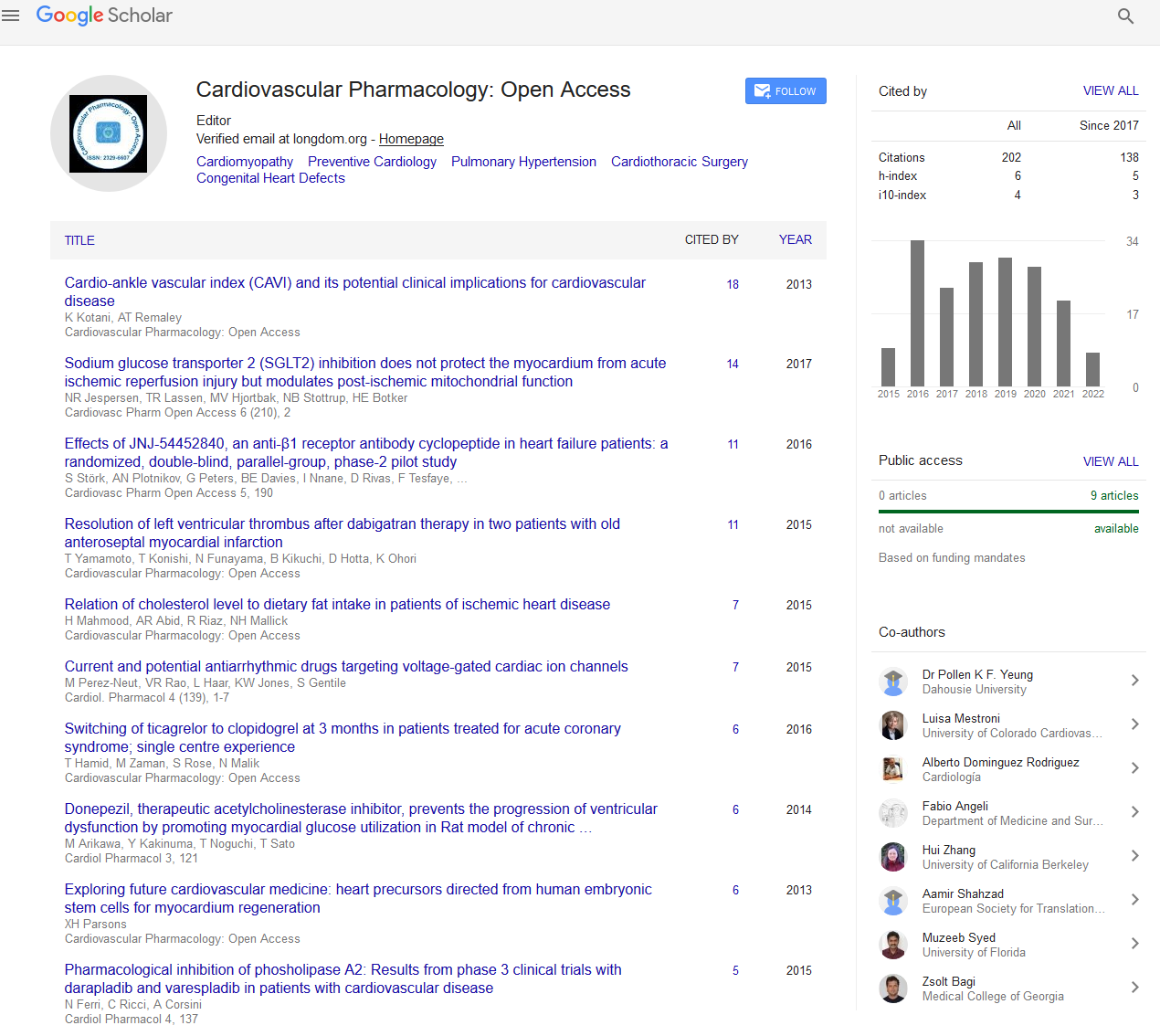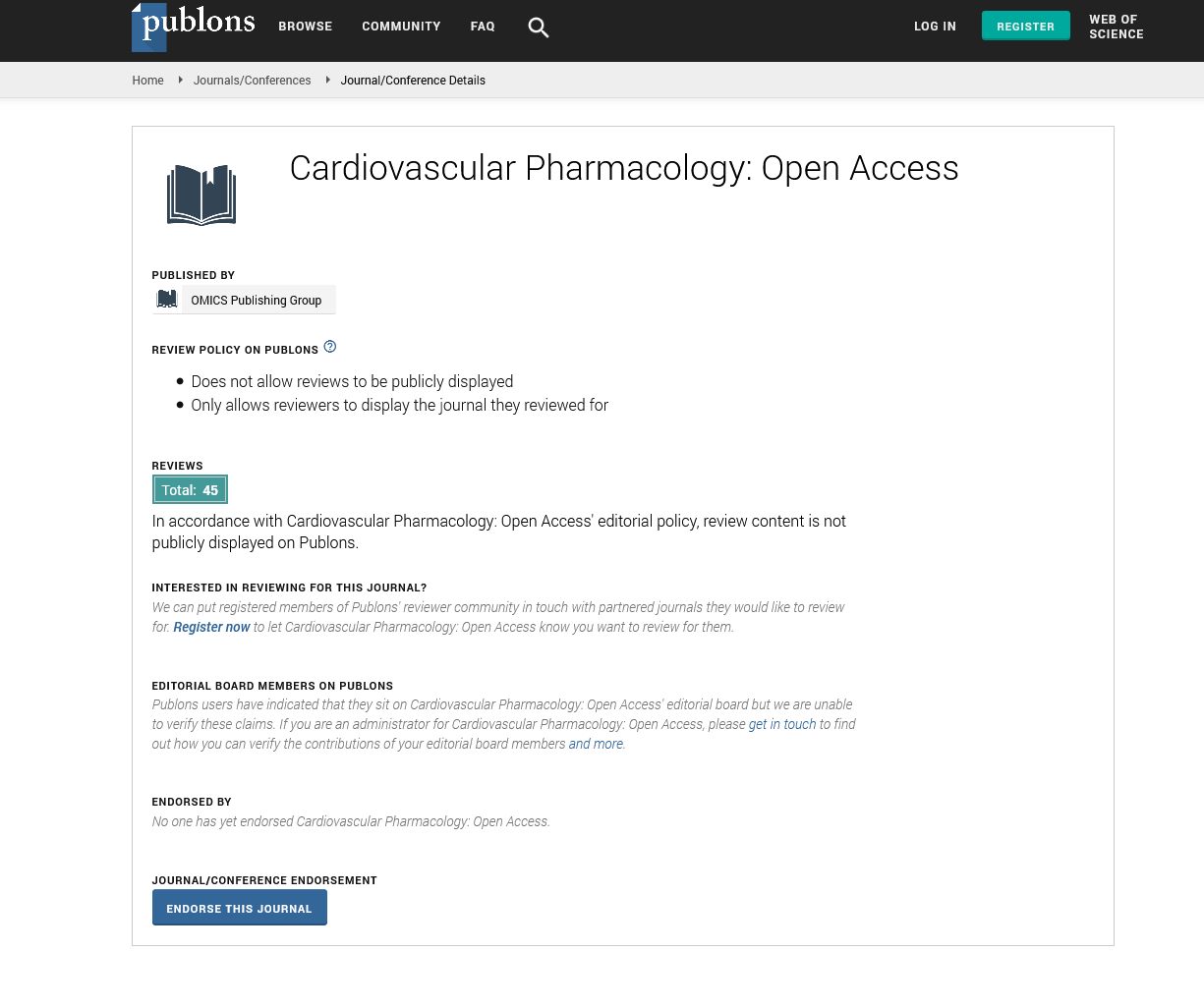Indexed In
- Open J Gate
- Cosmos IF
- RefSeek
- Hamdard University
- EBSCO A-Z
- OCLC- WorldCat
- Publons
- Geneva Foundation for Medical Education and Research
- Euro Pub
- Google Scholar
Useful Links
Share This Page
Journal Flyer

Open Access Journals
- Agri and Aquaculture
- Biochemistry
- Bioinformatics & Systems Biology
- Business & Management
- Chemistry
- Clinical Sciences
- Engineering
- Food & Nutrition
- General Science
- Genetics & Molecular Biology
- Immunology & Microbiology
- Medical Sciences
- Neuroscience & Psychology
- Nursing & Health Care
- Pharmaceutical Sciences
Short Communication - (2024) Volume 13, Issue 2
Novel Therapeutics in Cardiovascular Pharmacology: Emerging Drug Classes and Mechanisms of Action
Wanying Liu*Received: 24-May-2024, Manuscript No. CPO-24-27318; Editor assigned: 27-May-2024, Pre QC No. CPO-24-27318 (PQ); Reviewed: 10-Jun-2024, QC No. CPO-24-27318; Revised: 18-Jun-2024, Manuscript No. CPO-24-27318 (R); Published: 26-Jun-2024, DOI: 10.35248/2329-6607.24.13.398
Description
The field of cardiovascular pharmacology has long relied on traditional drug classes, such as beta-blockers, ACE inhibitors and statins, which have significantly improved outcomes in managing Cardiovascular Diseases (CVDs). However, persistent needs, such as treatment-resistant hypertension, high residual cardiovascular risk and recurrent heart failure, continue to drive research toward novel therapeutic options. Recent advancements have yielded potential drug classes that target diverse mechanisms beyond traditional pathways, offering new possibilities for CVD management. Some of these emerging drug classes, their mechanisms of action and their potential impact on the field of cardiovascular medicine.
PCSK9 inhibitors
PCSK9 (Proprotein Convertase Subtilisin/Kexin Type 9) inhibitors represent a development in lipid-lowering therapy, particularly for patients with familial hypercholesterolemia or those intolerant to statins. PCSK9, a protein that binds to LDL receptors on liver cells, targets these receptors for degradation, reducing the liver's capacity to clear LDL Cholesterol (LDL-C) from the blood [1]. By inhibiting PCSK9, these drugs allow LDL receptors to remain functional on liver cells, resulting in enhanced clearance of LDL-C and significant reductions in serum LDL levels.
Mechanism of action: PCSK9 inhibitors, such as alirocumab and evolocumab, are monoclonal antibodies that bind to PCSK9, preventing it from interacting with LDL receptors [2,3]. This blockade leads to an increased number of LDL receptors on the liver surface, thereby enhancing LDL-C clearance and reducing serum cholesterol levels.
SGLT2 inhibitors
Sodium-Glucose Cotransporter 2 (SGLT2) inhibitors, initially developed as glucose-lowering agents for diabetes, have shown remarkable cardiovascular benefits, particularly in heart failure. SGLT2 inhibitors, such as empagliflozin and dapagliflozin, reduce blood glucose levels by preventing glucose reabsorption in the kidneys, resulting in increased glucose excretion in urine [4,5]. Beyond their glycemic effects, these drugs have shown efficacy in reducing heart failure hospitalizations and cardiovascular mortality.
Mechanism of action: SGLT2 inhibitors act on the proximal tubule of the kidney to inhibit glucose and sodium reabsorption, leading to natriuresis (sodium excretion), osmotic diuresis (water excretion) and reduced blood volume. This, in turn, reduces blood pressure and improves left ventricular loading conditions, making them effective in heart failure management.
Angiotensin Receptor-Neprilysin Inhibitors (ARNIs):
ARNIs are a novel class combining an Angiotensin Receptor Blocker (ARB) with a neprilysin inhibitor, designed specifically for heart failure patients [6]. Neprilysin, an enzyme that degrades natriuretic peptides and other vasoactive substances, counteracts the benefits of the Renin-Angiotensin-Aldosterone System (RAAS). By inhibiting neprilysin, ARNIs enhance natriuretic peptide levels, promoting vasodilation, natriuresis and anti- fibrotic effects.
Mechanism of action: Sacubitril/valsartan (Entresto) is the first FDA-approved ARNI that combines the neprilysin inhibitor sacubitril with the ARB valsartan. Sacubitril inhibits neprilysin, increasing levels of natriuretic peptides that promote vasodilation and reduce blood volume. Valsartan blocks angiotensin II receptors, reducing vasoconstriction and aldosterone release, ultimately decreasing blood pressure and ventricular strain.
Soluble Guanylate Cyclase (sGC) stimulators
Soluble Guanylate Cyclase (sGC) stimulators are an emerging class of drugs that directly stimulate sGC, an enzyme that converts GTP to cyclic GMP (cGMP), a key signaling molecule in vascular relaxation. In CVD, oxidative stress often leads to reduced Nitric Oxide (NO) availability, impairing vasodilation and worsening hypertension [7]. sGC stimulators bypass the need for NO by directly activating sGC, enhancing vasodilation and reducing vascular resistance.
Mechanism of action: Drugs like vericiguat stimulate sGC directly, increasing intracellular cGMP levels in vascular smooth muscle cells. This pathway enhances smooth muscle relaxation, reducing blood pressure and improving cardiac function in heart failure patients.
Omega-3 fatty acid derivatives
Omega-3 fatty acids, long recognized for their cardiovascular benefits, have led to the development of specialized omega-3 fatty acid derivatives that show significant anti-inflammatory and lipid-modulating effects [8]. Icosapent ethyl, a purified Eicosapentaenoic Acid (EPA) derivative, has demonstrated cardiovascular benefits beyond standard lipid-lowering therapy.
Mechanism of action: Icosapent ethyl reduces triglyceride levels and has anti-inflammatory properties. It influences membrane composition, affecting the formation of pro-inflammatory mediators and reducing oxidative stress within vascular cells. Additionally, EPA-derived metabolites have been shown to inhibit platelet aggregation and reduce endothelial inflammation, contributing to plaque stability.
CETP inhibitors
Cholesteryl Ester Transfer Protein (CETP) inhibitors are a newer class of lipid-modulating drugs designed to raise High-Density Lipoprotein Cholesterol (HDL-C) and lower Low-Density Lipoprotein Cholesterol (LDL-C) [9]. Although early CETP inhibitors faced setbacks due to adverse effects, newer compounds, such as anacetrapib and evacetrapib, are showing renewed potential in cardiovascular outcomes.
Mechanism of action: CETP facilitates the transfer of cholesterol esters from HDL to LDL particles. Inhibiting CETP raises HDL-C levels and can lower LDL-C levels. By increasing HDL-C, CETP inhibitors aim to enhance reverse cholesterol transport, a process through which cholesterol is transported from peripheral tissues back to the liver for excretion.
Future directions and clinical implications
These novel drug classes represent significant advancements in cardiovascular pharmacology, providing additional options for patients who may not respond adequately to traditional therapies. As these drugs enter clinical practice, they offer the potential to reduce the burden of CVD and improve outcomes for millions of patients worldwide [10]. However, long-term studies are needed to fully understand their efficacy, safety and cost-effectiveness.
Conclusion
Emerging drug classes in cardiovascular pharmacology, such as PCSK9 inhibitors, SGLT2 inhibitors, ARNIs, sGC stimulators, omega-3 fatty acid derivatives and CETP inhibitors, offer new mechanisms of action that go beyond traditional pathways. These drugs address unmet needs in managing lipid levels, heart failure, inflammation and hypertension, representing a major shift toward more targeted and effective therapies. While these innovations potential improved patient outcomes, careful consideration of individual patient factors and long-term efficacy will guide their integration into clinical practice, ultimately advancing the fight against cardiovascular disease.
References
- Lother A, Hein L. Pharmacology of heart failure: From basic science to novel therapies. Pharmacol Ther. 2016;166:136-149.
[Crossref] [Google Scholar] [PubMed]
- Hulot JS, Trochu JN, Donal E, Galinier M, Logeart D, De Groote P, et al. Vericiguat for the treatment of heart failure: Mechanism of action and pharmacological properties compared with other emerging therapeutic options. Expert Opin Pharmacother. 2021;22(14):1847-1855.
[Crossref] [Google Scholar] [PubMed]
- Luscher TF, Barton M. Endothelins and endothelin receptor antagonists: Therapeutic considerations for a novel class of cardiovascular drugs. Circulation. 2000;102(19):2434-2440.
[Crossref] [Google Scholar] [PubMed]
- MacRae CA, Roden DM, Loscalzo J. The future of cardiovascular therapeutics. Circulation. 2016;133(25):2610-2617.
[Crossref] [Google Scholar] [PubMed]
- Nabel EG. Cardiovascular disease. N Engl J Med. 2003;349(1):60-72.
[Crossref] [Google Scholar] [PubMed]
- Ojha U, Ruddaraju S, Sabapathy N, Ravindran V, Worapongsatitaya P, Haq J, et al. Current and emerging classes of pharmacological agents for the management of hypertension. Am J Cardiovasc Drugs. 2022:1-5.
[Crossref] [Google Scholar] [PubMed]
- Azizi M, Rossignol P, Hulot JS. Emerging drug classes and their potential use in hypertension. Hypertension. 2019;74(5):1075-1083.
[Crossref] [Google Scholar] [PubMed]
- Aronson D, Krum H. Novel therapies in acute and chronic heart failure. Pharmacol Ther. 2012;135(1):1-7.
[Crossref] [Google Scholar] [PubMed]
- Figtree GA, Broadfoot K, Casadei B, Califf R, Crea F, Drummond GR, et al. A call to action for new global approaches to cardiovascular disease drug solutions. Eur Heart J. 2021;42(15):1464-1475.
[Crossref] [Google Scholar] [PubMed]
- Sattar N, Petrie MC, Zinman B, Januzzi JL. Novel diabetes drugs and the cardiovascular specialist. J Am Coll Cardiol. 2017;69(21):2646-2656.
[Crossref] [Google Scholars] [PubMed]
Citation: Liu W (2024). Novel Therapeutics in Cardiovascular Pharmacology: Emerging Drug Classes and Mechanisms of Action. Cardiovasc Pharm. 13:398.
Copyright: © 2024 Liu W. This is an open-access article distributed under the terms of the Creative Commons Attribution License, which permits unrestricted use, distribution and reproduction in any medium, provided the original author and source are credited.


